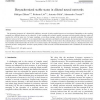Free Online Productivity Tools
i2Speak
i2Symbol
i2OCR
iTex2Img
iWeb2Print
iWeb2Shot
i2Type
iPdf2Split
iPdf2Merge
i2Bopomofo
i2Arabic
i2Style
i2Image
i2PDF
iLatex2Rtf
Sci2ools
IJON
2007
2007
Desynchronized stable states in diluted neural networks
The dynamical properties of a diluted fully inhibitory network of pulse-coupled neurons are investigated. Depending on the coupling strength, two different phases can be observed. At low coupling the evolution rapidly converges towards periodic attractors where all neurons fire with the same rate. At larger couplings, a new phase emerges, where all neurons are mutually unlocked. The irregular behavior turns out to be ‘‘confined’’ to an exponentially long, stationary and linearly stable transient. In this latter phase we also find an exponentially tailed distribution of the interspike intervals (ISIs). Finally, we show that in the unlocked phase a subset of the neurons can be eventually synchronized under the action of an external signal, the remaining part of the neurons acting as a background noise. The dynamics of these ‘‘background’’ neurons is quite peculiar, in that it reveals a broad ISI distribution with a coefficient of variation that is
| Added | 15 Dec 2010 |
| Updated | 15 Dec 2010 |
| Type | Journal |
| Year | 2007 |
| Where | IJON |
| Authors | Rüdiger Zillmer, Roberto Livi, Antonio Politi, Alessandro Torcini |
Comments (0)

